Sustainability Initiatives
Introduction
- Bharat Electronics Limited (BEL) is a Navratna PSU under the Ministry of Defence, Government of India.
- BEL is a Premier Professional Electronics Company engaged in the design and manufacture of state-of-the-art electronic professional grade electronics products and systems for the Army, Navy, Air Force, and other esteem customers.
Environment Management in Bharat Electronics:
- BEL is guided by a well-articulated Corporate Environmental Policy keeping long term environmental sustainability in
- Sustainability is a way of life at BEL, the company is certified for ISO 14001:2015 Environmental Management System, addresses environmental issues in a wider perspective with a firm resolve to reduce all forms of
Sustainable Growth:
The Company has established “Sustainable policy” in line with Government of India, Department of Public Enterprises (DPE) guidelines on Sustainable Development (SD) for Central Public Enterprises (CPSEs).
Company undertakes necessary initiatives towards optimization and continuous reduction in utilization of natural resources and also man-made resources Environment sustainability projects on water, waste or energy management, promotion of renewable source of energy, biodiversity conservation etc.; Projects for reduction, reuse and recycle of waste materials, rain water harvesting and replenishing the ground water supply, protection, conservation and restoration of eco-system, reduction of carbon emission through energy efficient and renewable energy technologies, greening the supply chain and innovation in production and services which are part of sustainable development programme.
Energy Sustainability:
With growing concern for Green House Gas (GHG) emissions and environmental degradation, BEL intended to shift towards tapping “Clean & Renewable” Energy sources for meeting our power requirements. In this regard, BEL has initiated steps to achieve “Carbon Neutral Status” through renewable energy resources and energy conservation measures.
Aim is to achieve Carbon Neutral and Net Zero Grid by 2025-26
ROADMAP TO ACHIEVE RE 100 STATUS (NET ZERO GRID ENERGY)

Wind Energy Power Plants:
BEL is proactive to conserve energy, one best way is to achieve this is by harnessing the renewable energy. The company has set up wind farms of cumulative capacity 13.9 MW. The energy generated from these plants is wheeled to BEL, Bengaluru Complex through banking arrangement for captive consumption.
| Capacity | Commissioning year | Generation since commissioning (in kWh) | Reduction in equivalent CO2 emission since inception (in Tons) |
|---|---|---|---|
| 2.5MW | 2006 | 1099,12,045.47 | 102471 |
| 3MW | 2008 | 797,61,879.22 | 74362 |
| 8.4MW | 2016 | 534,21,645.39 | 49805 |
| 4 MW | 2025 | planned | |
Total Energy generation from Wind Power plants till date is 28.12 crore units, leading to reduction in CO2 emissions of 2,26,638 Tonnes cumulatively.
Additional 4 MW wind power plant installation is in the pipe to enhance renewable energy contribution.
Roof Top Solar Power Plants:
The total cumulative capacity of Grid connected Solar Power plant is 5.1 MWp which are installed at roof tops of various buildings of all BEL Units. 54 Lakh units of energy was generated. This has contributed about 9.8% of the total energy consumption of all units of BEL.
Total renewable energy contribution during the year 2022-23 is around 49% of total energy consumption.
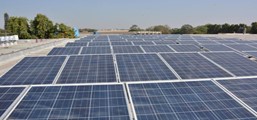
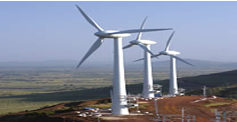
Battery based Energy Storage System:
Energy generation from Renewable Energy (RE) projects depends on day-to-day weather conditions and, therefore, the energy produced is highly variable and intermittent in nature. In order to deal with the intermittency of RE supply, adequate balancing resources need to be developed and deployed to provide clean, affordable, reliable and sustainable power. A Battery based Energy Storage System (BESS) is proposed in addition to roof top solar plants termed as “Solar plus storage” was planned as a Proof of concept (POC) demonstration. In order to assess options to integrate distributed energy storage and evaluate the associated benefits and cost, a 100kWh Battery based Energy Storage System (BESS) was established. Subsequently, additional capacity of 200kW 100kWh BESS has been installed inside BEL premises as an alternate to fossil fuel based 250KVA DG set.
A total capacity of 5 MWh capacity Battery Energy Storage System (BESS) is planned as per Road map drawn to reduce dependency on DG sets for short duration power failures and peak load shifting to control Maximum demand.
Energy Conservations measures:
- Installation of Energy efficient centrifugal air compressors
- Introduction of VRV based air conditioning systems.
- Energy efficient motors for pumps, blowers with variable frequency drives for motors and centrifugal fans of cooling towers
- Usage of energy efficient 5 star rated split air conditioners and cold storage
- Optimization of air conditioning areas and usage of portable chillers to minimize energy
- Energy efficient screw chillers in AC plants for meeting variable cooling load demand
- DALI based Lighting Management System with occupancy-based lighting controls and daylight harvesting at new
- Installation of LED for indoor and outdoor lighting applications
- HVAV (Heating Ventilation and Air Conditioning) automation for effective / optimized operation and monitoring of critical HVAC
- Usage of Inverter type split air conditioners for 24×7 operations like UPS rooms, Battery rooms etc
Water Sustainability:
BEL has established a systematic approach for water sustainability through.
- Roof top harvesting for reuse
- Recharging of Ground water table
- Re-use of tertiary treated water
- Conservation of water
ROADMAP TO ACHIEVE WATER POSITIVE STATUS

a. Roof top harvesting for reuse
Roof top rainwater harvesting was created for reuse of water for RO generation; this enables every year to collect 500-600 m3 of rainwater of low TDS which in turns result in use of saving about 800-1000 m3 of fresh water.
b. Recharging of Ground water Table
Following are the recharging methodology adopted for recharging the ground water table
- Local recharging pits
- Large scale reservoir
Innovative recharging of bore wells enable us to collect the runoff water adjacent to the building and near to the borewells for facilitating recharging of aquifers. 45 recharge pits have been created in BG campus of 685 acres. Overflow from recharging pit is diverted to large-scale rainwater harvesting reservoir having capacity of 170 million liters with expected annual yield of around 234 million liters.
Rainwater harvesting pond


c. Re-use of tertiary treated water
- BEL had the foresight to install in the early 1980s a wastewater treatment plant to treat the sewage and effluent treatment plant which was pursued further to reach reuse level after tertiary treatment to the present state of zero discharge.
- The process effluents after treatment are reused in electroplating applications whereas the domestic effluents are used for horticulture purposes. Wastewater generated is treated to meet the Pollution Control Board norms.
- Company ensures Zero Discharge.
d. Conservation of water:
Conservation of water through various initiatives such as:
- Changing over from Water cooled Compressors to Air Cooled compressors.
- Process flow modification to synchronize sequences of operations in solar wafer manufacturing.
- Installation of auto level control switches in sumps and overhead tanks
- Introduction of Sprinkler Irrigation System in place of manual spray for effective water utilization
- Introduction of Sludge dewatering system for recovery of water
- Introduction of Dual-plumbing system in the new buildings
- Reuse of treated water for production and horticulture instead of fresh water
- Smart ground water management through timer-based pumping system
- Air agitation in process tank for lesser water requirement for cleaning
- Demand based water management system.
- Installation of sewage treatment plant of 300 KLD at Kotadwar unit for achieving Zero liquid discharge
Rejuvenation of lake – for Urban water Management – Success story of Rejuvenation of Doddabommasandra lake
Doddabommasandra lake is one of the main lakes in cascading series of Lake Narasipura, Lake Tindlu, which overflows to Lake Hebbal, and finally forms the Dakshina Peenakini River, which flows towards Malur and joins into the Kaveri River. Beginning in the late 1990s, with a change in the rain pattern and no runoff from Thindlu and Narasipura Lake to Doddabommasandra Lake, this lake became dry around 2002. The scale of the problem was beyond imagination, the wells in and around the area were slowly running out of water. Water scarcity was the major problem faced by around 3 lakh residents of Doddabommasandra water shed region in the Vidyaranyapura, Govindayyanpalya, Thindlu and BEL areas.
Bharat Electronics Limited has taken up rejuvenation of Doddabommasandra lake by setting up of 10 MLD Sewage Treatment Plant with a project costing 13.5 crores under BEL Corporate Social Responsibility (CSR) scheme. Project is about Rejuvenation of Lake by augmentation of evaporation losses in the lake during the summer by supplementing treated sewage of upstream area as a source of water. Except for the rainy season, lakes used to be dry, and biodiversity of lake was totally disturbed. This used to happen over a decade.
In view of this, BEL has taken up rejuvenation of lake by setting up of 10MLD STP to improve flora and fauna by lake water full in all the season. The project has taken up in collaboration with Karnataka Lake Conservation and Development Authority (KLCDA), the Bruhath Bengaluru Mahanagara Palike (BBMP) and the Revenue Department.
The STP is designed on “Sequential Batch Reactor (SBR)” Technology using PLC/SCADA control, a process in which the sewage is fed into the SBR units for biological treatment, and it is advanced treatment of “Activated Sludge Process (ASP)”. The plant will be maintained by BEL for a period of 20 years.

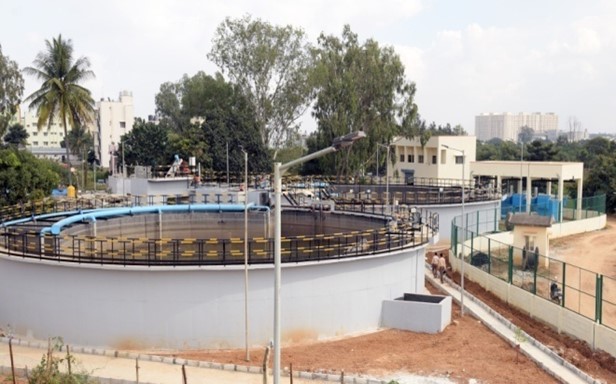
The benefit of the above project is promoting Flora and Fauna, Raising ground water level by ground water recharging, encouraging the birds and mammals to breed and improving environment and reduction in Pollution by preventing disposal of sewage water in lake.
Cleaner Technology:
- The pursuit of continuous improvement in the introduction of clean technologies in the electronic manufacturing processes is always ongoing backed up by a strong R&D
- RoHS-compliant components and processes are introduced to comply with the European & other international directives such as
- Surface treatment activity in PCB manufacturing
- Use of low-smoke halogen cables
- Low-VOC finishing processes (polyurethane) and trivalent chromate conversion coatings, based on chrome.
Green Buildings:
BEL has introduced the Green Building concept in all new buildings Integrated Habitat Assessment to meet the GRIHA rating compliance. The concept starts right from the design to balance infrastructure needs and environmental protection and reduce energy footprint.
- Using more Natural Lighting
- Wind powered roof extractors for internal
- Puff insulated roofing sheets to reduce heat
- Orientation of building to avoid heat due to direct
- Variable Refrigerant Volume System to optimize Air- Conditioning
- Integrated Building Management System (IBMS)
- Skylight pipe system for lighting interiors.
Ecological Sustainability:
We embark on a journey of ecological sustainability and greenery at BEL. Around 1500 different types of plants are grown in our campuses and it is a home to various birds and other creatures. On our 685-hectare green campus in Bangalore, we maintain a lawn of approximately 5,18,000 square metres and hedges of 23,000 metres as well as over 1,41,000 trees.
The green carpet helps hold back dust, absorbs heat, creates a carbon sink, and releases fresh oxygen. Lush green plantations on several hectares of land are a testimony to Bharat Electronics’ commitment to Afforestation.
Greenery inside BEL
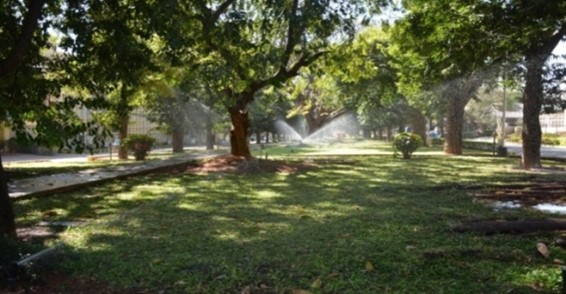
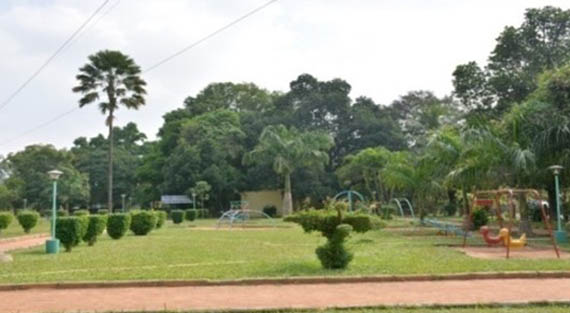
Technology for Climate resilient agriculture:
The collaboration between ICAR-IIHR and BEL to pave the way for research and development in sensor-based systems for enabling precision agriculture. By utilising state-of-the-art sensors and data analytics. The project aims to optimise resource usage, monitor crop health, and improve overall farm management.
Both ICAR-IIHR and BEL anticipate that the outcomes of this collaboration will greatly benefit farmers, enhance food production, and contribute to the sustainable development of the agriculture sector.
Bio methanation of waste:
We have installed source segregation system for proper handling of waste. We have a 1.0 tonne organic waste converter to compost biodegradable food and green waste of colony. Manure thus generated is used for horticulture application in our estate. The green waste is naturally composted, and a leaf shredder is used to reduce its quantum. Canteen food waste is processed at the 2 tonne Bio-Methanation plant to generate biogas for cooking which saves ~50 SCM PNG. Landfillable waste is processed at solid waste treatment facility in Bengaluru.


Awards and Accolades:
In appreciation of our committed environmental performance BEL, Bangalore Complex has been bestowed with the following awards:
- Karnataka Parisara Prashasthi Award from Government of Karnataka – 1999
- Mother Theresa Memorial National Award for Best Environmental & Ecological Implementation – 2003
- Golden Peacock Environment Management Award by World Environment Foundation – 2004
- Karnataka State award for Energy Conservation- first position in the general category – 2006
- Excellent Water Efficient Unit Award 2010 and Water Efficient Unit (Beyond the Fence) Award by the Confederation of Indian Industry – 2010
- National Energy Conservation Award in the General Category sector – 2011.
- State Energy Conservation Award – 2011
- Mentor Graphics Silicon India Leadership Award 2015 for the ‘Best VLSI/Embedded Design in Government sector.
- Dun & Bradstreet ‘India’s Top PSUs Award’ for Electrical & Electronic Equipment sector – 2016
- ASSOCHAM Responsible Organization Excellence Award – 2016
- ELCINA-EFY Awards for Quality (1st prize in Large Scale category) and Exports (2nd prize in Large Scale category).
- Dainik Bhaskar India Pride Award
- Greentech Energy Conservation Award – 2021
